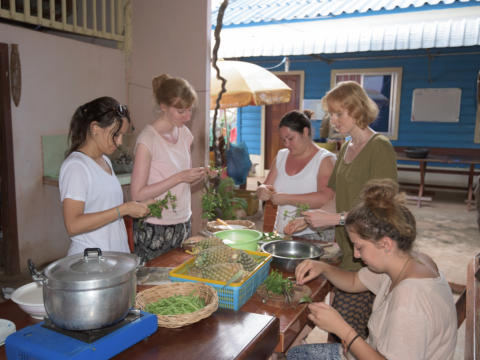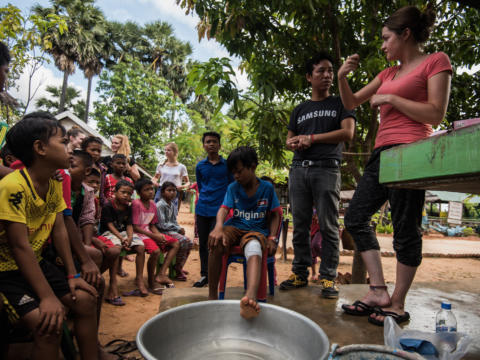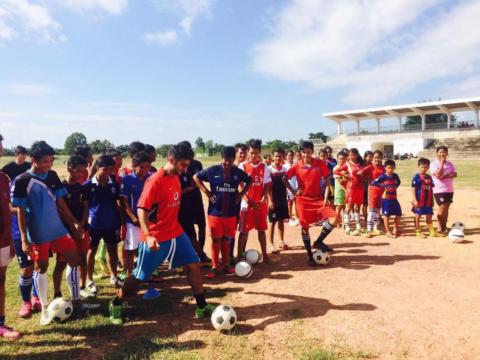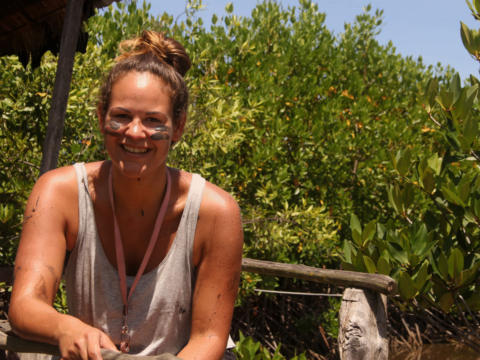Only 360€ per week!
Greenway School
Samraong - Cambodia
Greenway School
Samraong - Cambodia
Teach English to students who attend our school in remote Cambodia!
The Greenway School in the Pul village of Samraong teaches English to children from poorer backgrounds. Our local teachers will help you with preparing lessons and taking charge of your class, following our structured curriculum and weekly testing cycles. You might teach alone or alongside other internationals, like yourself, as a team.
Program Description
Every day, more than 400 children arrive at the Greenway School in Samraong to attend one of the two sessions offered.
All of them are eager to learn and are extremely appreciative of those who can assist them with their educational development. The school was designed, built and completely operated by people like you, under the guidance of our native Cambodian manager and teacher Mr. Ya Nuth.
Since beginning his work with this rural Samraong community in 2008, Mr. Ya Nuth has become a leader in the local community. His efforts in developing local schools and hospitals, with the help of those like yourself, has had an immeasurably positive effect on the community. In 2013, the Greenway School was opened, offering a free educational/learning opportunity for those who couldn’t otherwise afford it.
Students attend a regular public school for three hours per day, where they don’t get the chance to learn a lot of English. The public school shifts are divided into a morning group and an afternoon group, giving the children a chance to come to our school during their free time (e.g. the morning group can attend our afternoon shift and vice versa). What is so unique and amazing about the Greenway School, is that the children come of their own accord and truly enjoy their time here.
Teaching takes place in a traditional classroom setting. However, we are very flexible and encourage you to be creative in your lesson planning. The most important thing to consider is that you remain within the scope of the established curriculum and its schedule.
Participants can expect to work alongside other local teachers or participants. This could mean 3-5 participants taking turns with providing instruction during the course of the session. This could allow for smaller group engagement and when needed, one-on-one help for students who may be having challenges with the material. There will be an orientation before starting your work with students. During that orientation, the exact size, level of assignment and members of the teaching team will be determined.
To facilitate maximum learning and comprehension, you will need to continue the pace that has been set by school directors for the class you are working with. In order to ensure that the material is covered fully and the schedule is maintained, you will not be allowed to skip ahead. All participants will follow the prescribed curriculum and provide adequate review, which will allow students to be better prepared for weekly progress and end of year assessment tests.
The children who come to Greenway School, come from the Pul village, as well as five other surrounding villages. Their ages range from 6 to 15. Most currently possess just a basic level of English, but using our established curriculum, we are able to accommodate beginners all the way up to level 5.
Class sizes are typically between 10-30 students. Classrooms are equipped with basic teaching resources, such as a whiteboard and flash cards. You are highly encouraged to bring small learning materials and items to use in your class and/or donate to our school. These things are gratefully received and help to broaden the curriculum and teaching possibilities that we can offer.
The primary mode of transport to and from the accommodation/school will be on bicycles.
The core focus of the teaching project will depend upon the needs of the school at that particular point in time. Your main roles will be (but are not limited to):
- Preparing English lesson plans
- Teaching English
- Administering weekly progress tests
Besides passing on your English knowledge, you may also be able to share some basic hygiene and sanitation routines, as well as, your own experiences and cultural background.
Aims & Objectives
- Improve village children’s educational prospects
- Provide learning tools that empower students to create a better future for themselves
- Gain invaluable, practical experience in teaching
- Facilitate a cultural exchange which broadens the perspectives of all engaged
- Assist the local staff by providing an extra hand
Schedule
Monday to Friday
Teaching time with the students is divided into two shifts, with lunch and free time back at the accommodation in between. The first shift begins in the morning from 08:00 -11:00 while the afternoon shift is from 14:00 – 17:00. You should also expect to spend time working on the next day’s activities/exercises, so that you are prepared and comfortable for the duration of the lesson.
Note: This schedule can be changed and/or amended depending on weather conditions, local conditions and unforeseen circumstances.
Participant Criteria & Requirements
Standard Requirements
Minimum age: –
Maximum age: –
Minimum English level: Intermediate
CRB required: On Signup
Passport copy required: No
Resume copy required: No
Required qualification: None
Additional Requirements
- Modest clothing (covering the knees and shoulders) required while at school or in community
Additional Equipment
No specific equipment required for this program.
Location
Samraong, which name translates from Khmer into “impenetrable jungle”, is a town located in northwestern Cambodia, close to the border with Thailand. You will be located in a small, rural village located in the outskirts of town. This remote location will give you a taste of what rural Cambodia looks and feels like, while at the same time allowing you to explore some of Cambodia’s highlights, as Siem Reap is located only two hours away.
About the Accommodation
The accommodation in Samraong is simple and natural. There are no laundry facilities, so expect to wash your clothes by hand. However, there are some places that you can do laundry in the town for a small cost.
All locations have a communal area where you can eat, relax, meet fellow participants or use the free Wifi. Requests for specific locations or room configurations cannot be guaranteed.
There are bikes available, which you can use to explore the area during your free time!
For participants desiring more comfort and/or privacy, families, couples, and more mature participants, we recommend upgrading to a comfort room. These rooms have more amenities and may be in a different location than the standard rooms, which means that it may be noticeably quieter.
Food Arrangements
Prepare your palate! During your stay the meals will be typical Cambodian style, which includes plenty of rice and noodle dishes. On a few occasions there may be meat, but generally speaking there is no western food served. Vegetarian options are available..
Facilities
There are ATMs in Samraong, as well as a bank. There are numerous local shops where you can get all the basics you might need during your stay. Depending on the location of your accommodation, these may be accessible within a 10 – 15 minute bike ride or walk.
Activities & Events
No scheduled activities outside the program.
Sights & Surroundings
There is a nearby park where you can relax or play volleyball with locals during your free time.
Further away is Siem Reap, which is two hours away from the accommodation. Participants often opt to head there during the weekends to explore the famous Angkor Wat and more!
Transportation
From this location we provide free transport to your next program at the following location(s):
- Siem Reap
- Kampot
- Banteay Chhmar
Quick Facts
Name: Kingdom of Cambodia
Population: 15.14
Capital: Phnom Penh
Language: Khmer
Currency: Riel (KHR)
Time zone: UTC +7
Country Information
Once known as the Khmer empire, Cambodia is perhaps best known for its monumental temples, especially that of Angkor Wat – finalist in the election of the new 7 wonders of the world in 2006. It is without doubt a country of incredible beauty, scattered with these temples, fertile rice fields and a rich and interesting history. For this reason it is unsurprising that Cambodia has taken a firm place on the tourist map. Having been a protectorate of France for almost 100 years, the country gained its independence in 1953. Following this however, Cambodia experienced years of civil war, turmoil and political corruption, as well as suffering from its involvement in the Vietnam war.
Despite holding this dark history, Cambodia really is an extraordinary country and has prevailed due to what has been described as the unbreakable spirit of the Cambodian people. The people here are known for their friendliness and their smiles.
Climate
Cambodia has monsoon climate with temperatures ranging from 21°C – 35°C (The average year-round temperature is 27.7°C). Its monsoon season spans from May – October, whilst dry season lasts from November to December . Dry season is the most popular time to visit however rainy season can be incredibly beautiful in Cambodia due to the richer colours that it causes. The rain also can help to make temperatures more pleasant. Post-monsoon season is also a favourite time to visit because of the stunning green countryside
Whilst temperatures do not vary hugely, during the winter the northern parts of the country can be colder.
Culture
Buddhism is an important aspect of Khmer cultural and is practiced by 95% of the Cambodian population.
Gastronomy
In true Asian style, the staple food in Cambodia is rice whilst fish from the Mekong river plays another major part in Khmer cuisine. You can also expect to find use of noodles, soups, stir-fries, curries and salads and so there is something to suit everyone’s taste. The french colonial influence can even be seen in the use of toasted baguette with Cambodian red curry.
It has to be said that the Cambodian cuisine is relatively unknown compared to that of Thailand and Vietnam.
Transportation
Taxi
Taxis are becoming increasingly popular in Cambodia however there are still very few metered taxis, especially anywhere outside of Phnom penh.
Cyclo
This are a cheap and practical way to get around in towns/cities. In Phnom Penh, drivers can be flagged down on main roads or found waiting around markets and hotels. You should expect to bargain and set a price before the journey.
Moto
Motorcycle taxis are a quick and cheap way to get around in a city. Prices may rise at night and like the cyclo, you should expect to bargain and agree on a price before the journey. It should be noted that Cyclo/moto drivers may speak little to no English.
Rotei Ses
Cart rides are common in the more remote/rural parts of Cambodia
Bus
Whilst Cambodia has no train service, buses provide a good alternative for the longer distance journeys/ travel into neighbouring countries.
Flight
Commercial flights connect the main tourist areas in Cambodia





